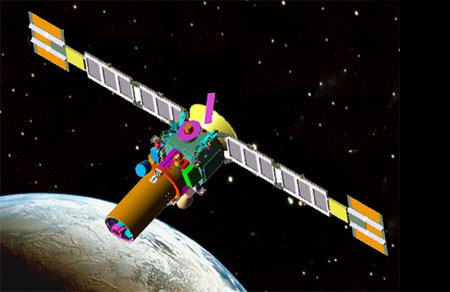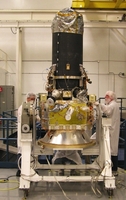Linux blasts off in U.S. tactical satellite
Dec 19, 2006 — by LinuxDevices Staff — from the LinuxDevices Archive — 4 views Linux was shot into space Dec. 16, as part of a second-phase Air Force Research Laboratory program aimed at making space more “operationally responsive.” The TacSat-2 (tactical satellite) program aims to create “micro satellites” that can be launched quickly and cheaply, to support tactical military operations.
Linux was shot into space Dec. 16, as part of a second-phase Air Force Research Laboratory program aimed at making space more “operationally responsive.” The TacSat-2 (tactical satellite) program aims to create “micro satellites” that can be launched quickly and cheaply, to support tactical military operations.
digg this story |
Todd Brackett, PTR Group president, explains, “Say the Marines are going to land on a beach, and you want a satellite's view of the situation, but you don't have access to one of the big national asset satellites. That kind of access is very difficult to get for tactical purposes. You want to quickly create a satellite and get it up in space, and over the space you're interested in. We're proving you can do that, leveraging COTS solutions, easy solutions, and free software.”

Illustration of TacSat-2 satellite
 TacSat2's readied for testing (Click to enlarge) |
Saturday's TacSat-2 launch left from the Wallops Flight Facility, on Wallops Island, in Va. Linux is reportedly running on the micro satellite's “TIE” (Target Indicator Experiment) payload, one of about half a dozen blade-based systems on the approximately 220-pound micro satellite (pictured at right).
The Linux-powered TIE payload is an RF (radio frequency) sensor suite said to be capable of gathering a variety of signals, including the maritime AIS (automatic identification system) signals currently required on large ships for port safety and homeland defense purposes.
The TIE sensor was developed by the Naval Research Lab, on top of an application-ready Linux system created by PTR Group. The Herndon, Va.-based independent embedded consulting firm developed, ported, and integrated the Linux kernel, device drivers, and other related system software, so that NRL engineers could “concentrate on the RF mission,” according to Brackett.
Brackett said the TacSat-2 program involves “at least four satellites, with a fifth in genesis,” but notes that the satellite carrying the TIE payload was the first to launch. “We're one of many vendors involved in the project,” he said.
Linux was also a part of last year's TacSat-1 effort, powering the Copperfield-2 payload, as described in LinuxJournal.
PTR Group Engineer Jeff Angielski stated, “In essence, this is the successor to the Copperfield system presented in the Linux Journal for Tacsat-1, the main differences being we now have two CPU cards instead of one, support for AIS, and the SEI capability has been merged into a single cPCI card.”
Angielski adds, “One [CPU card] has a Motorola PowerPC MPC8265, a Xilinx VirtexII FPGA, and an RF front-end daughter card. They are populated with 128MB of RAM and 32MB of flash.
“The PowerPC CPUs are running a modified version of the DENX ELDK 3.1 Linux 2.4.25. The bootloader is U-Boot 1.1.2.
“The root filesystem was hand-built using a set of build scripts which overlaid the various makefile subsystems. The core component of the root filesystem is BusyBox. However, we could not leverage all of BusyBox since some of its components were missing key features. For these cases we integrated the full feature version of the software. And of course we had to add all of the payload specific software into the root filesystem.”
[Photos courtesy of the U.S. Air Force.]
This article was originally published on LinuxDevices.com and has been donated to the open source community by QuinStreet Inc. Please visit LinuxToday.com for up-to-date news and articles about Linux and open source.